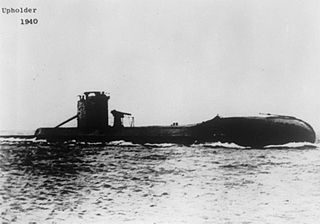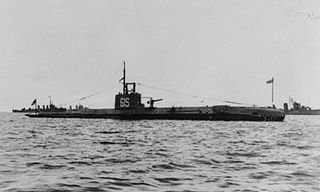
HMS Upholder (P37) was a Royal Navy U-class submarine built by Vickers-Armstrong at Barrow-in-Furness. She was laid down on 30 October 1939, launched on 8 July 1940 by Mrs. Doris Thompson, wife of a director of the builders. The submarine was commissioned on 31 October 1940. She was one of four U-class submarines which had two external torpedo tubes at the bows in addition to the 4 internal ones fitted to all boats. They were excluded from the others because they interfered with depth-keeping at periscope depth.

Rear Admiral Sir Anthony Cecil Capel Miers,, known as "Crap Miers" and "Gamp", was a Royal Navy officer who served in the submarine service during the Second World War.

Admiral Sir Max Kennedy Horton, was a British submariner during the First World War and commander-in-chief of the Western Approaches in the later half of the Second World War, responsible for British participation in the Battle of the Atlantic.
HMS P41 was a Royal Navy U-class submarine built by Vickers-Armstrong. She was transferred to the exiled Royal Norwegian Navy before completion and renamed HNoMS Uredd. She and one of the B-class in 1940 have so far been the only Norwegian submarines to have been sunk.

HMS Electra was a one of nine E-class destroyers built for the Royal Navy during the 1930s. Sunk in the Battle of the Java Sea, Electra was a witness to many naval battles, including the Battle of the Denmark Strait and the sinking of Prince of Wales and Repulse. The ship's wreck was discovered in 2003 and had been badly damaged by illegal salvagers by 2016.

Operation Berlin was a raid conducted by the two German Scharnhorst-class battleships against Allied shipping in the North Atlantic between 22 January and 22 March 1941. It formed part of the Battle of the Atlantic during World War II. The Scharnhorst and Gneisenau sailed from Germany, operated across the North Atlantic, sank or captured 22 Allied merchant vessels, and finished their mission by docking in occupied France. The British military sought to locate and attack the German battleships, but failed to damage them.

HMS Seahorse was a first-batch S-class submarine built for the Royal Navy during the 1930s. Ordered in March 1931, she was laid down at Chatham Dockyard in September 1931 and launched on 15 November 1932.

HMS Swordfish (61S) was a first-batch S-class submarine built for the Royal Navy during the 1930s. Commissioned in 1932, she was given the pennant number 61S and was assigned to the 2nd Submarine Flotilla.

HMS Sturgeon was an S-class submarine that entered service with the Royal Navy in 1932. Ordered in 1930, she was laid down at Chatham Dockyard in January 1931 and launched on 8 January 1932. Commissioned on 27 February 1933, Sturgeon was assigned to the 2nd Submarine Flotilla.

HMS Thames (N71) was an ocean-going type of submarine of the River Class. She was built by Vickers Armstrong, Barrow and launched on 26 February 1932. She was completed on 14 September 1932, and after commissioning was assigned to the Mediterranean, stationed at Malta.

HNoMS Ula, previously HMS Varne, a British-built U-class submarine, and a member of the third group of that class to be built. She never actually served under the name Varne, being transferred before commissioning to the exiled Royal Norwegian Navy as HNoMS Ula (S300). In 1944 she sank a German U-boat during one of her patrols off Norway. She remained in Norwegian service and was scrapped in 1965.
HMS H49 was a British H-class submarine built by William Beardmore and Company, Dalmuir. She was launched on 15 July 1919 and commissioned on 25 October 1919. The submarine saw active service in the Second World War, but was sunk off the Netherlands by German patrol vessels on 18 October 1940.

Vice-Admiral Sir Arthur Richard Hezlet, nicknamed Baldy Hezlet, was a decorated Royal Navy submariner. He became the Royal Navy's youngest captain at the time – aged 36 – and its youngest admiral, aged 45. In retirement he became a military historian.
Vorpostenboot, also referred to as VP-Boats, flakships or outpost boats, were German patrol boats which served during both World Wars. They were used around coastal areas and in coastal operations, and were tasked with – among other things – coastal patrol, ship escort, and naval combat.

The Atlantic U-boat campaign of World War I was the prolonged naval conflict between German submarines and the Allied navies in Atlantic waters—the seas around the British Isles, the North Sea and the coast of France.

O 13 was an O 12-class submarine of the Royal Netherlands Navy that saw service during World War II. She was built by the Koninklijke Maatschappij De Schelde of Vlissingen. She was one of many Dutch ships doing convoy duty during the Spanish Civil War. At the time of the German invasion of the Netherlands, O 13 was on patrol off the Dutch coast and was attacked by German planes on multiple occasions. After fleeing to England, the submarine was lost during a patrol on the North Sea.
MV Abosso was a passenger, mail, and cargo liner, the flagship of Elder Dempster Lines. In peacetime she ran scheduled services between Liverpool and West Africa. In the Second World War she was a troop ship, running between the United Kingdom, West Africa, and South Africa.

Iltis was the lead ship of her class of six torpedo boats built for the German Navy during the 1920s. The boat made multiple non-intervention patrols during the Spanish Civil War in the late 1930s. During World War II, she did not participate in the Norwegian Campaign of 1940 as she was under repair after having accidentally rammed and sunk a U-boat. Iltis spent the next couple of years escorting minelayers as they laid minefields and laying minefields herself. She also spent the latter half of 1941 escorting convoys through the Skaggerak. The boat returned to France in 1942 and was one of the escorts for the capital ships sailing from France to Germany through the English Channel in the Channel Dash. Iltis then helped to escort one commerce raider through the Channel and was sunk by British forces while escorting another blockade runner in May.

Jaguar was the sixth and last Type 24 torpedo boat built for the German Navy during the 1920s. The boat made multiple non-intervention patrols during the Spanish Civil War in the late 1930s. During World War II, she played a minor role in the Norwegian Campaign of 1940. Jaguar spent the next several months escorting minelayers as they laid minefields and damaged heavy ships back to Germany before she was transferred to France around September. She started laying minefields herself that month and continued to do so for the rest of the war. After a refit in early 1941, the boat was transferred to the Skaggerak where she was assigned escort duties. Jaguar returned to France in 1942 and was one of the escorts for the capital ships sailing from France to Germany through the English Channel in the Channel Dash. She helped to escort blockade runners, commerce raiders and submarines through the Channel and the Bay of Biscay, as well as Norwegian waters, for the next several years. The boat attacked Allied ships during the Invasion of Normandy in June 1944, but was sunk by British bombers that same month.

Operation Northern Mark was a sortie by a German flotilla of two battleships and a heavy cruiser against British merchant shipping between Norway and Shetland from 18 to 20 February 1940. The sortie was intended as a riposte to the Altmark incident, to create confusion to help German blockade-runners reach home and as a prelude to more ambitious operations in the Atlantic. The flotilla was spotted by the British early on, who held back a Norway-bound convoy.

















